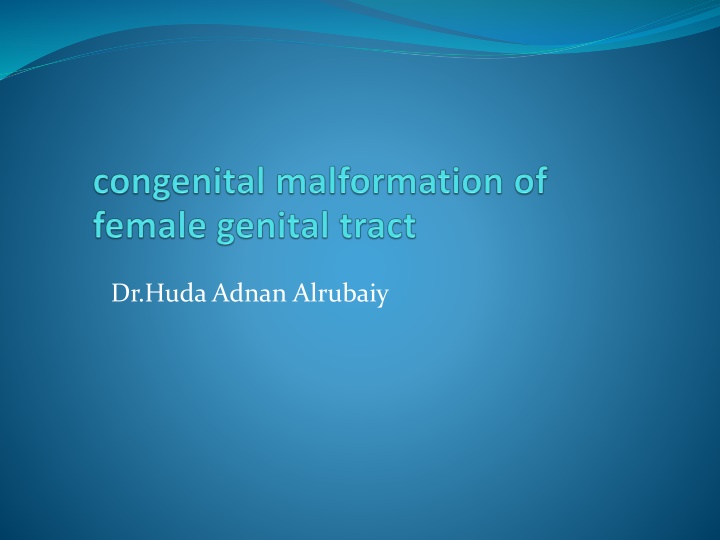
Genetic and Anatomical Differentiation in Human Embryos
Explore the normal genetic and anatomical differentiation processes in human embryos, including the role of chromosomes in determining sex, development of genital structures, and common disorders impacting sexual development like Turner syndrome and congenital adrenal hyperplasia.
Download Presentation

Please find below an Image/Link to download the presentation.
The content on the website is provided AS IS for your information and personal use only. It may not be sold, licensed, or shared on other websites without obtaining consent from the author. If you encounter any issues during the download, it is possible that the publisher has removed the file from their server.
You are allowed to download the files provided on this website for personal or commercial use, subject to the condition that they are used lawfully. All files are the property of their respective owners.
The content on the website is provided AS IS for your information and personal use only. It may not be sold, licensed, or shared on other websites without obtaining consent from the author.
E N D
Presentation Transcript
Normal genetic differentiation Following fertilization the normal embryo contain 46 chromosomes including 22 autosomes and one chromosome derived from each parent . 46 xx develop as a female and 46 xy develop as a male. Y chromosome contain a region known as SRY region (sex determining region of the chr. Y) , in males this gene triggers testis formation. Ovarian differentiation determined by the presence of two x chromosomes and ovarian determinant gene lacated on short arm of X chromosome.
Normal anatomical differentiation Embryologically mesonephric (wollfian) develop into male genital structures The two paramesonephric (mullarian) ducts develop as upper female genital structures including fallopian tubes and after fusion of both tubes develop into uterus, upper third of vagina. Urogenital sinus develop into lower two thirds of vagina. Ovaries differentiated from coelomic epithelium.
Disorders of sexual development Hearmophroditisim In which ovarian snd testicular tissue present at the same time ina various degree result in ambigious genitalia. Most common karyotyping 46xx but may be 46xx/xy or 46 xy. Management The sex will determined at puberty by gender role or functional capability of the external genitalia and removal of inappropriate organ.
Congenital adrenal hyperplasia Most common disorder. Defficiency of 21 hydroxylase enzyme lead to increase 17 hydroxyprogesteron. Karyotyping 46xx Autosomal recessive disease. Present at birth as abigious external genitalia like labial adhesion and clitoral hyperatrophy and salts losing syndrom, normal internal organs Management by replacement of minalocorticoid at birth and cortisol adminsteration long life.
Turner syndrom Karyotyping 45O Phenotyp female with features of short stature, webbed neck,shield shape thorax, elbow deformity, priamary amenorrhea due to gonadal dysgenesis, cardiac and renal diseases. Management by hormon replacement therapy by estrogen and growth hormon to achieve height of 150 cm and breast development and after age of 11 years by estrogen and progesteron . Pregnancy can be obtained by ova donation.
5 alpha reductase deficiency Karyotyping 46 xy The defect in 5 alpha reductase which responsible for conversion of testosteron into dihydrotestosteron which is important in development of male external genitalia. Presented as abmigious genitalia at birth and some degree of virilization at puberty. Sex determined by gender role
Androgen insensitivity syndrom Karyotyping 46 xy Receptors not respond to testosteron hormon . Presented with female external genitalia at birth and absence of menstruation(no uterus) and spare axillary and pubic hair at puberty, blind end vagina, with presense of testis in the abdomen or inguinal region. Management by gonadectomy after pubert because of risk gonadoblastoma and creation of vagina for sexual satisfaction.
Mayar-Rokatinsky-Kuster-Hauser syndrom Karyotyping 46 xx Mullarian agenesis result in absent uterus and tube and upper vagina. Female present with normal external genitalia ,blind end vagina and normal secondary sexual charechteristices with primary amenorrhea. Associated with urinary tract anomalies in 40% and skelatal abnormality in 25%. Management by psychological counselling,vaginal cration and pregnancy by surrogate uterus.
Other structural malformation Imperforated hymen due to incomplete canalization of vagina, managed by crciate incision of hymen. Septate uterus due to incomplete failure of fusion of two mullarian ducts may present with recurrent misscariage and malpresentatin during labor and management by removal of septum Uterine didyphylus dut to complete failure of fusion of two mullarian ducts (pregnancy occur in one cavity) Bicornuate uterus when there is deep indentation of fundus present with recurrent misscarriage and malpresentation. Unicornuate uterus when there is failure of developemrnt of one mullarian duct associated with recuurent misscarriage and ectopic pregnancy.
Longtudinal vaginal septum presented with dyspareunia managed by removal of septum. Transverse vaginal septum presented with primary amenorrhea managed by surgical removal of septum.
